Farofa is a traditional Brazilian dish made from toasted cassava flour, often mixed with butter, salt, and various ingredients like onions, eggs, and bacon for added flavor.
Key Takeaways:
- Farofa, made from toasted cassava flour, is a staple in Brazilian cuisine.
- It’s versatile, complementing many dishes like feijoada, rice and beans, and churrasco.
- Recipes include traditional, egg, gourmet, banana, and corn flakes farofa.
- Farofa is gluten-free, enriching meals with texture and flavor.
- It’s celebrated across Brazil, reflecting the country’s diverse culinary heritage.
Welcome to the vibrant world of Brazilian cuisine, where the humble yet iconic Farofa takes center stage.
This golden, toasted treasure, made from cassava flour, is more than just a side dish; it’s a cultural symbol, embodying the diversity and richness of Brazil’s culinary landscape.
Farofa’s versatility knows no bounds, seamlessly complementing a variety of Brazilian dishes, from the hearty feijoada to the festive churrasco. It’s a testament to Brazilian creativity in the kitchen, turning simple ingredients into something truly extraordinary.
Join me as we delve into the essence of food in Brazil through the lens of Farofa, a culinary adventure that promises to tantalize your taste buds and enrich your understanding of Brazil’s gastronomic heritage.
What is the brazilian food farofa?
Farofa is a traditional Brazilian dish made from toasted cassava flour, often mixed with butter, salt, and various ingredients like onions, eggs, and bacon for added flavor.
Originating from indigenous Brazilian cuisine, it has become a staple across the country, symbolizing the blending of cultural influences in Brazil’s culinary history.
Farofa is highly versatile, served alongside a variety of Brazilian meals, and is especially popular during festive occasions. Its texture and ability to absorb flavors make it a beloved addition to the Brazilian dining experience.
What is cassava flour, the main ingredient of farofa?
Cassava flour, the main ingredient in farofa, is made from the root of the cassava plant, also known as yuca or manioc.
This flour is gluten-free and plays a crucial role in Brazilian diets, especially as a staple in gluten-free and allergy-friendly cooking.
The traditional process of making cassava flour involves peeling, washing, grating, and then drying the cassava root before grinding it into flour.
In Brazil, the type of cassava flour used for farofa is usually coarser and more granulated, giving farofa its distinctive texture. This flour’s versatility and nutritional value make it an essential component of Brazilian cuisine.
Which regions of Brazil eat farofa?
Farofa is universally eaten across all regions of Brazil, from the Amazon to the southern states.
Its preparation and ingredients might vary locally, reflecting the diverse culinary traditions of each region, but its presence is a constant, underscoring its importance in Brazilian cuisine.
Whether as a daily staple or a festive treat, farofa connects Brazilians to their cultural heritage, making it a truly national dish.
Also See | Brazilian Capoeira: Dance, Fight, and Cultural Journey
How to make farofa brazilian food?
Making farofa, a beloved Brazilian food, involves various styles that cater to different tastes and occasions.
The basic method starts with toasting cassava flour in butter or oil, to which a variety of ingredients can be added for flavor, such as onions, garlic, eggs, and bacon.
As you’ll see below, the recipes vary between using oil and butter, in this part, the choice is personal, I usually use both, I start with the oil and finish by adding a little butter to make the farofa tastier.
Regional and personal preferences lead to diverse versions like the festive farofa enriched with dried fruits and nuts for Christmas, or the simple everyday style enjoyed with rice and beans.
Each variation of farofa showcases a unique aspect of Brazil’s rich culinary tradition, making it a versatile and indispensable part of Brazilian cuisine.
Plan your trip to Brazil
- Find the cheapest flights
- Discover the best accommodation
- Explore this incredible country with the best experiences
- Stay connected at all times with an eSIM
Traditional Farofa: The classic simplicity of cassava flour and seasonings
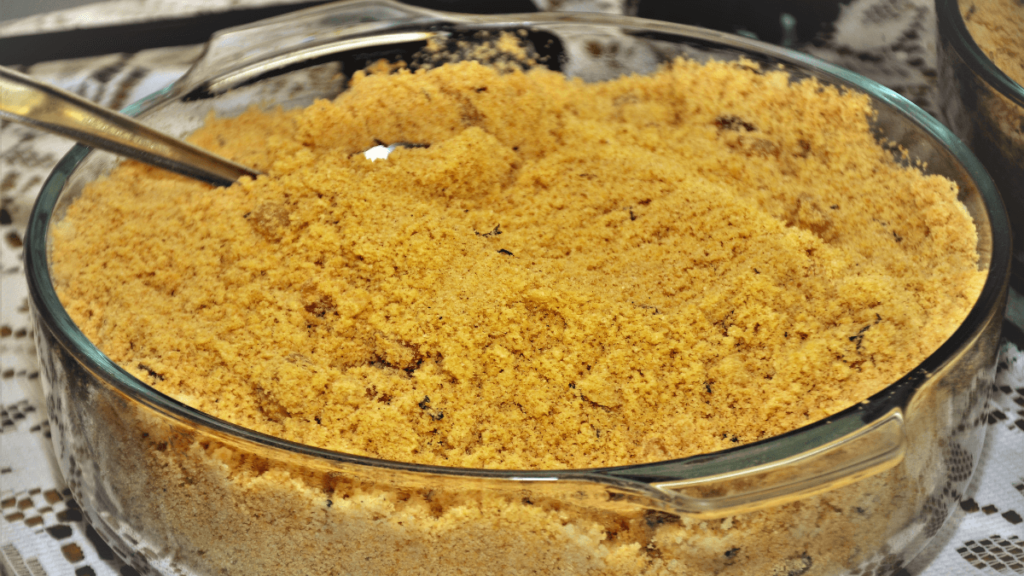
To create traditional farofa, you’ll need the following basic ingredients and steps. Adjust quantities based on your preference and the number of servings.
Ingredients:
- 2 cups of cassava flour (coarse is preferable for texture)
- 1/2 cup of butter or olive oil
- 1 medium onion, finely chopped
- Salt and black pepper to taste
- Optional: chopped parsley or green onions for garnish
Method of Preparation:
- Heat the Fat: In a large skillet, melt the butter or heat the olive oil over medium heat.
- Sauté the Onion: Add the chopped onion to the skillet and sauté until translucent and slightly golden.
- Toast the Flour: Gradually add the cassava flour to the skillet, stirring constantly to ensure it’s evenly mixed with the butter and onion. Cook until the flour is golden and fragrant.
- Season: Season with salt and black pepper to taste. Adjust the seasoning as needed.
- Serve: If using, garnish with chopped parsley or green onions just before serving.
This simple recipe is the foundation of farofa, allowing for numerous variations and additions such as eggs, bacon, sausage, or vegetables to enhance the flavor and richness of the dish.
In the video below you can see a traditional farofa recipe made only with butter, onion and cassava flour:
Egg Farofa: Another common version
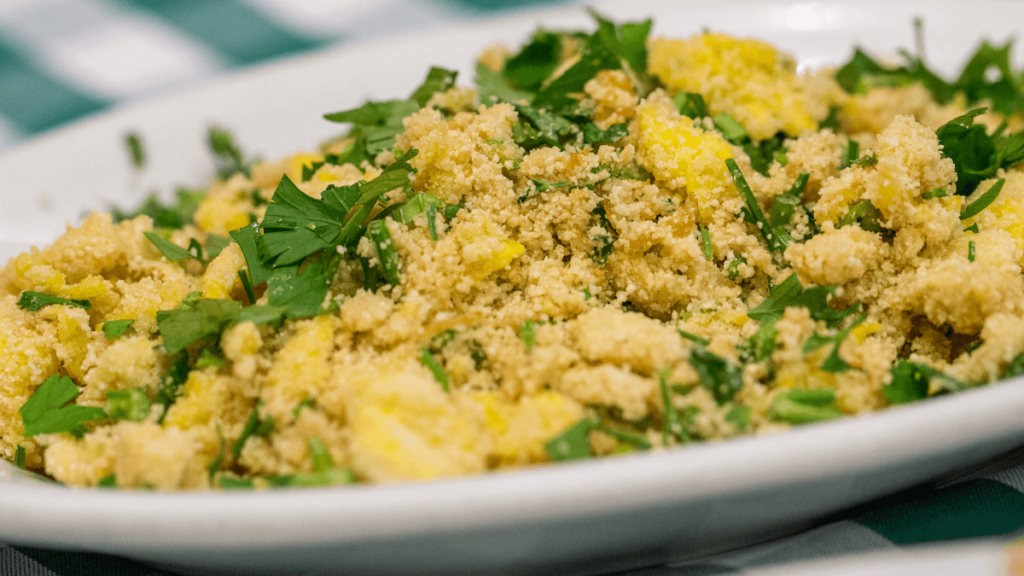
This is the version I eat most often, it’s delicious.
Ingredients:
- 2 cups of cassava flour
- 4 tablespoons of butter
- 1 onion, finely chopped
- 4 eggs
- Salt and pepper to taste
- Chopped parsley for garnish
Preparation:
- Melt butter in a pan and sauté the onion until soft.
- Beat the eggs and pour them over the onions, scrambling until cooked.
- Gradually add the cassava flour, stirring constantly, until the mixture is evenly toasted.
- Season with salt and pepper, garnish with parsley, and serve warm.
- This Egg Farofa is a flavorful addition to many Brazilian meals, offering a rich and satisfying texture.
Gourmet Farofa: Elevating Farofa with meats, bacon, and luxurious complements
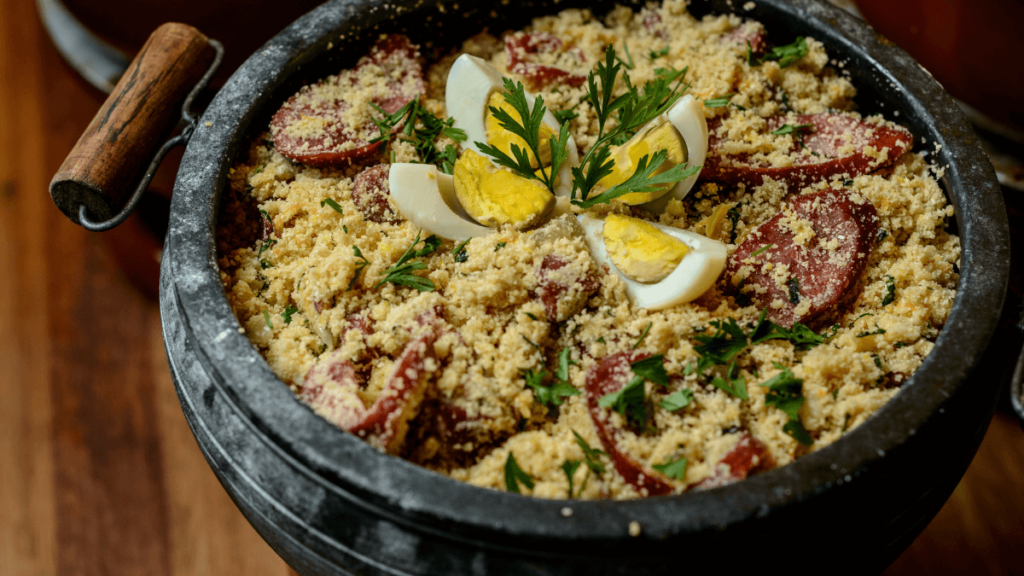
This version of Farofa is more luxurious, making it a special addition to holiday feasts or as an accompaniment to more elaborated dishes.
Ingredients:
- Cassava flour
- Butter or olive oil
- Diced bacon
- Cubed smoked sausage or chorizo
- Finely chopped onions
- Minced garlic
- Chopped parsley and green onions for garnish
- Optional: dried fruits like raisins, diced boiled eggs, or nuts for extra texture and flavor
Preparation:
- Start by rendering the bacon and sausage in a pan to release their fats.
- Sauté onions and garlic in the same pan, using the rendered fat for added flavor.
- Gradually add cassava flour, stirring constantly until golden.
- Mix in any optional ingredients like dried fruits or nuts.
- Season with salt and pepper, garnish with fresh herbs, and serve warm.
Banana farofa: My favorite
This recipe balances the savory notes of the farofa with the natural sweetness of bananas, creating a unique side dish that complements a variety of main courses.
Ingredients:
- 2 cups of cassava flour
- 4 ripe bananas, sliced
- 1/2 cup of butter
- 1 large onion, finely chopped
- Salt to taste
- A handful of chopped parsley for garnish
Preparation Method:
- Melt Butter: In a large skillet, melt the butter over medium heat.
- Caramelize Bananas: Add the sliced bananas to the skillet and cook until they start to caramelize, then remove them and set aside.
- Cook Onion: In the same skillet, add the chopped onion and sauté until translucent.
- Toast Cassava Flour: Add the cassava flour to the skillet with the onions, stirring continuously until it’s well mixed and starts to toast.
- Combine with Bananas: Gently fold the caramelized bananas back into the skillet with the toasted cassava flour, mixing carefully to combine.
- Season and Serve: Season with salt to taste. Finish by sprinkling chopped parsley over the farofa before serving.
Corn flakes farofa
Brazil’s traditional farofa is made with manioc flour, but you can also find variations, such as one that uses cornflakes.
Ingredients:
- 2 cups of unsweetened corn flakes, lightly crushed
- 1/2 cup of butter or olive oil
- 1 medium onion, finely chopped
- 2 cloves of garlic, minced
- 1/2 cup of diced carrots (optional for added color and texture)
- Salt and black pepper to taste
- Fresh parsley, chopped (for garnish)
Preparation Method:
- Prepare the Ingredients: Start by lightly crushing the corn flakes to a coarse texture. Finely chop the onion, mince the garlic, and dice the carrots if using.
- Cook the Onion and Garlic: In a large skillet, heat the butter or olive oil over medium heat. Add the onion and garlic, sautéing until they are soft and golden.
- Add the Corn Flakes: Stir in the lightly crushed corn flakes, mixing well to ensure they are coated with the butter and onion mixture. Cook for a few minutes until the corn flakes are slightly toasted.
- Add Carrots: If using carrots, add them now and cook until they are just tender.
- Season: Season the mixture with salt and black pepper to taste.
- Garnish and Serve: Remove from heat, garnish with fresh parsley, and serve as a side dish.
How does farofa taste like?
Farofa has a unique taste and texture that can vary depending on the ingredients used. Traditionally, it has a nutty, slightly smoky flavor from the toasted cassava flour, enriched by the butter or oil it’s cooked in.
Add-ons like onions, garlic, bacon, or eggs contribute savory notes, while banana or raisins can add a hint of sweetness.
The texture is grainy and crunchy, providing a delightful contrast to the softer dishes it accompanies, such as beans and stews. Farofa’s versatility allows it to absorb and complement the flavors of the main dish it’s served with.
Is farofa gluten-free?
Yes, Farofa is naturally gluten-free because it’s made from cassava flour, which comes from the cassava root, a staple food in Brazil that doesn’t contain gluten.
This makes Farofa an excellent choice for those following a gluten-free diet.
But it is by no means a low-calorie dish that is recommended to be eaten every day. To make a true Brazilian farofa, with its unique flavor, you need to use a good amount of fat, either oil or butter, which makes it a high-calorie preparation.
How is the farofa served?
Farofa serves as a versatile side dish, never taking center stage but always enhancing the flavors of the main course.
Check out some traditional Brazilian dishes that are usually served with farofa:
Feijoada
Feijoada is Brazil’s national dish, a hearty stew of black beans and a variety of pork or beef parts. It’s traditionally served on Wednesdays and Saturdays and is a social meal meant for sharing.
Farofa, when sprinkled on top, adds a delightful crunch that contrasts the tender textures of the meat and the creaminess of the beans, enhancing the overall richness of the dish.
Rice and beans
In Brazil, rice and beans are everyday staples, offering a simple yet nutritious meal.
Farofa adds a necessary texture and flavor contrast, turning an ordinary meal into something more exciting.
The cassava flour absorbs the bean sauce, enriching its taste and making each bite more satisfying.
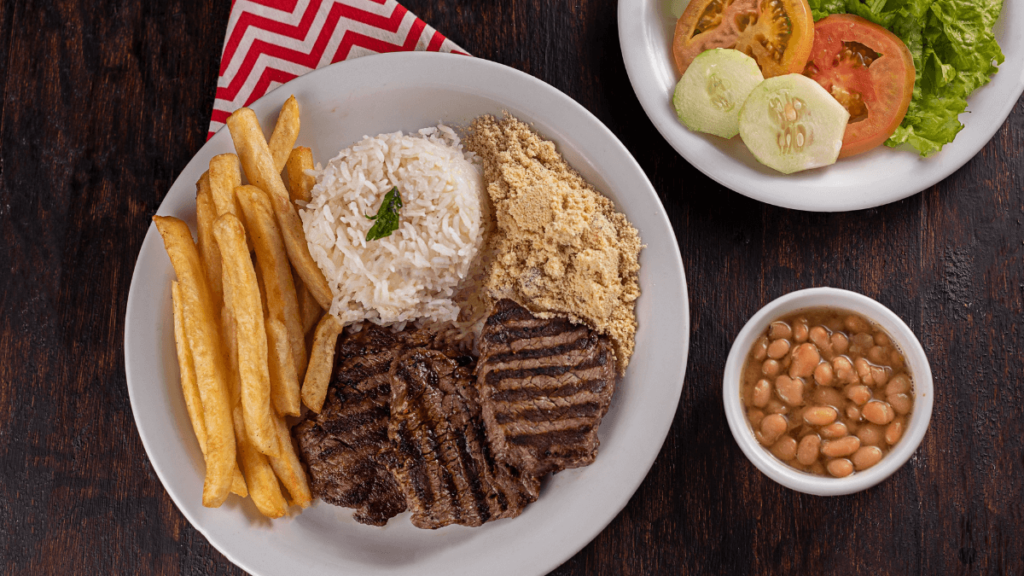
Arroz Carreteiro
Arroz Carreteiro is a traditional dish made with rice and dried meat, often prepared over a campfire by cowboys of the Brazilian pampas.
Adding farofa to Arroz Carreteiro introduces an extra layer of texture and flavor, making this already flavorful dish even more robust and hearty.
Moqueca
Moqueca is a fragrant Brazilian fish stew cooked with coconut milk, tomatoes, onions, garlic, and coriander.
Banana farofa, with its slight sweetness, complements the rich, spicy flavors of Moqueca, providing a unique balance that highlights the stew’s complexity.
Barbecue (Churrasco)
Brazilian barbecue, or churrasco, is famous for its variety of grilled meats. Farofa is often served alongside, ready to be sprinkled over the meats or eaten on the side.
Its crunchy texture and savory flavor are perfect for cutting through the richness of the meat, making each bite even more enjoyable.
The ready-made farofa, which you can buy in the market, is used to serve with the meat in a Brazilian barbecue.
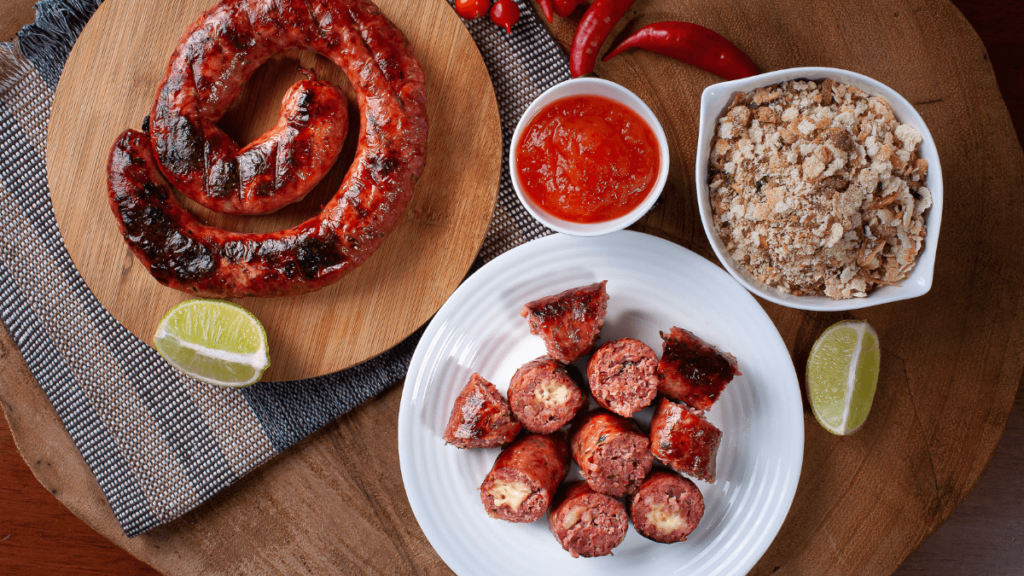
Where to buy farofa and manioc flour outside Brazil?
If you want to try farofa, there are 3 ways to do it outside Brazil:
- Looking for Brazilian restaurants in your area;
- Buying cassava flour to make the recipe at home;
- Or by buying ready-made farofa in Brazilian markets.
However, remember that ready-made farofa is used to accompany meats on the Brazilian barbecue, because it is simpler and doesn’t require any cooking, although it is good, it is definitely not the traditional Brazilian farofa we are talking about in this text.
Do you want to immerse yourself in delicious Brazilian cuisine? You definitely need to try farofa
Farofa is more than just a dish; it’s a celebration of Brazilian culture and cuisine, shared around the world. This versatile, gluten-free side dish, made from toasted cassava flour, adds a unique texture and flavor to any meal.
Whether it’s your first taste or a familiar comfort, farofa invites you to explore the richness of Brazilian culinary traditions.
With its simple ingredients and varied recipes, farofa embodies the spirit of Brazilian hospitality, making it a beloved addition to tables far beyond Brazil’s borders.
Did you like our content, do you want to get to know our country?! Discover the best experiences to live in Brazil!




